By collecting and analyzing stories from a variety of indigenous cultures in North America, researchers find evidence for a mid-air explosion of a comet or asteroid, similar to the Tunguska event. Plus, a new Trojan for Earth, volcanoes and dinosaurs, ancient Mexican cacao groves, and this week in rocket history is Lunar Orbiter 3.
Podcast
Show Notes
Second (and largest) Earth Trojan asteroid found
- NOIRLab press release
- “Orbital stability analysis and photometric characterization of the second Earth Trojan asteroid 2020 XL5,” T. Santana-Ros et al., 2022 February 1, Nature Communications
Do planets form around dying binary stars?
- KU Leuven press release
- “A population of transition disks around evolved stars: Fingerprints of planets,” J. Kluska et al., 2022 February 1, Astronomy & Astrophysics
Comet changed history in the Americas
- UC Cincinnati press release
- “The Hopewell airburst event, 1699–1567 years ago (252–383 CE),” Kenneth Barnett Tankersley et al., 2022 February 1, Scientific Reports
Volcanoes actually helped dinosaurs thrive
- Tohoku University press release
- “Volcanic temperature changes modulated volatile release and climate fluctuations at the end-Triassic mass extinction,” Kunio Kaiho et al., 2022 February 1, Earth and Planetary Science Letters
Sacred cacao grown in sinkholes
- BYU press release
- “Soil biomarkers of cacao tree cultivation in the sacred cacao groves of the northern Maya lowlands,” Richard E. Terry et al., 2022 January 6, Journal of Archaeological Science: Reports
ATLAS observatory expands to two more countries
- University of Hawai’i press release
This Week In Rocket History: Lunar Orbiter 3
- Lunar Orbiter 3 (NASA)
Transcript
Hello and welcome to the Daily Space. I am your host Dr. Pamela Gay.
And I am your host Beth Johnson.
And we’re here to put science in your brain.
Today’s science is a bit of an Earth-based grab bag. First, there’s this newly confirmed Earth Trojan asteroid and then a possible comet impact learned of through the accounts of North American indigenous people.
From there we look at how volcanoes may have helped dinosaurs evolve and dominate the fauna of Earth, and we hunt down ancient cacao groves in Mexico.
Finally, Erik will join us to present this week in rocket history, which is all about Lunar Orbiter 3, one of the missions that prepared our astronauts for the Apollo Moon landings.

One of the latest missions we have been covering has been the Lucy mission to Jupiter’s Trojan asteroids – those asteroids that orbit about 60 degrees in front of and behind the gas giant. Jupiter, it turns out, is not the only planet with Trojan asteroids. Mars, Neptune, and Uranus all have Trojans as well, although not nearly as many as Jupiter. And Earth, up until this week, was known to have one Trojan. But now, NOIRLab has announced the discovery of a second, larger Earth Trojan.
In a new paper published in Nature Communications, scientists detail the discovery of 2020 XL5 which was confirmed using the Southern Astrophysical Research (SOAR) telescope in Chile. The asteroid was originally found with the Pan-STARRS1 survey telescope in Hawai’i back in December 2020. It’s about 1.2 kilometers in diameter, which makes it three times wider than Earth’s other known Trojan asteroid, 2010 TK7.
The team not only observed 2020 XL5 with the SOAR telescope but went back and looked through precovery data from the Dark Energy Survey to put together nearly ten years of data and images. This meant that they could determine the size, orbit, and even type of asteroid our largest (so far) Trojan is. Lead author Toni Santana-Ros notes: SOAR’s data allowed us to make a first photometric analysis of the object, revealing that 2020 XL5 is likely a C-type asteroid, with a size larger than one kilometer.
Now, 2020 XL5 will not always be a Trojan asteroid of Earth. Its orbit is predicted to only be stable for the next 4,000 years or so before gravitational perturbations will nudge it away and out into deeper space.
It should be noted that while we may have only confirmed two Earth Trojans, it’s expected that there are many more. They are hard to observe, however, because they end up being close to the Sun in the sky. You have to look for them close to sunrise or sunset, and you have to aim your telescope near the horizon, where the atmosphere is thickest. That means, as all you astrophotographers know, the seeing is the worst. SOAR can be pointed just 16 degrees above the horizon, which is lower than most 4-meter and larger telescopes can aim, making it the best one for the challenge.
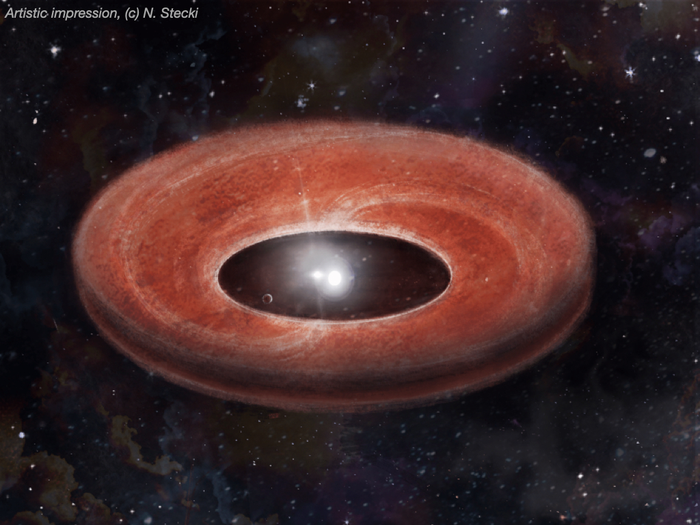
One of the reasons we look for or send spacecraft to objects like Trojan asteroids is that they provide us with primitive samples of the early solar system. Almost everything in our solar system is about 4.6 billion years old since the Sun formed and the leftover gas and dust became a protoplanetary disk that spawned all our worlds and rocks and such. And from our observations of other planetary systems, we thought they were much the same. Until now.
In new research published in Astronomy & Astrophysics, scientists describe how a binary star system, where one star is dying and throwing out gas and dust, may have a baby planet forming from that material. First author Jacques Kluska explains: In ten percent of the evolved binary stars with discs we studied, we see a large cavity in the disc. This is an indication that something is floating around there that has collected all matter in the area of the cavity.
And that cleanup could be the work of a new planet. The researchers found more evidence for this possibility when they analyzed the surface of the dying white dwarf. Kluska goes on to explain: In the evolved binary stars with a large cavity in the disc, we saw that heavy elements such as iron were very scarce on the surface of the dying star. This observation leads one to suspect that dust particles rich in these elements were trapped by a planet.
What’s really interesting is that this work wasn’t about one star system; it was about 85 binary star systems. The team combed through existing observations of those 85 star systems and found that ten binary pairs showed evidence of gaps with new planets forming. Planets gonna planet, I guess.
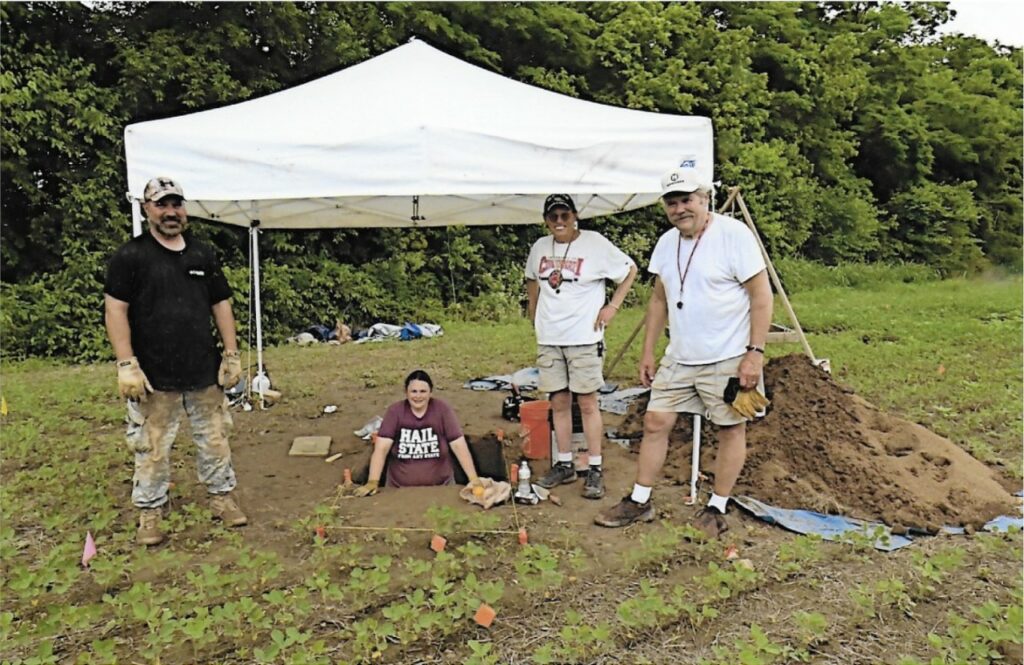
There are days when I think it’s a good thing that planets get so many opportunities to do the whole planet thing. A lot can go wrong in the history of a world, and new research has found that not all attacks from space leave dramatic impacts on the land; sometimes, the evidence is hidden in the histories and arts of human societies.
Throughout the North American indigenous cultures, there are stories of a great terror coming from the sky: the Miami called it a horned serpent, the Shawnee saw it as a sky panther that tore down the forest, the Ottawa said the Sun fell from the sky, and the Wyandot recount a dark cloud that rolled across the sky and was destroyed by a fiery dart. From modern-day Florida to Ottawa, these stories are told.
These stories mirror the descriptions of the people who witnessed the Tunguska event in Siberia, which is now believed to be the explosion of a comet or asteroid that made it into the atmosphere but not to the surface of the land. The primary difference is that the stories we hear from the indigenous peoples of the Americas have been passed down for generations, and it is then easy to label them as mythology instead of as descriptive accounts by pre-science people of an actual event. Which it appears is what they are.
Research teams exploring the end of the Hopewell culture have uncovered evidence for a massive air explosion in the form of large numbers of meteorites spread across multiple Hopewell sites. According to lead researcher Kenneth Tankersley: These micrometeorites have a chemical fingerprint. Cosmic events like asteroids and comet airbursts leave behind high quantities of a rare element known as platinum. The problem is platinum also occurs in volcanic eruptions. So we also look for another rare element found in non-terrestrial events such as meteorite impact craters — iridium. And we found a spike in both, iridium and platinum.
In addition to meteorites being strewn throughout the sites, they also found jewelry and musical instruments made out of meteorites.
While the stories and artifacts are awesome, they are also tied to a time the society collapsed. The layers with meteorites are tied to ash and signs of massive regional fires. Co-author of this work, David Lentz, explains: It looks like this event was very injurious to agriculture. People didn’t have good ways to store corn for a long period of time. Losing a crop or two would have caused widespread suffering.
This work was published in the journal Scientific Reports and is a strong reminder that the Universe is trying to kill us, and sometimes, it succeeds.
Coming up next we have three more stories on planetary alterations brought to you by geology and space science.
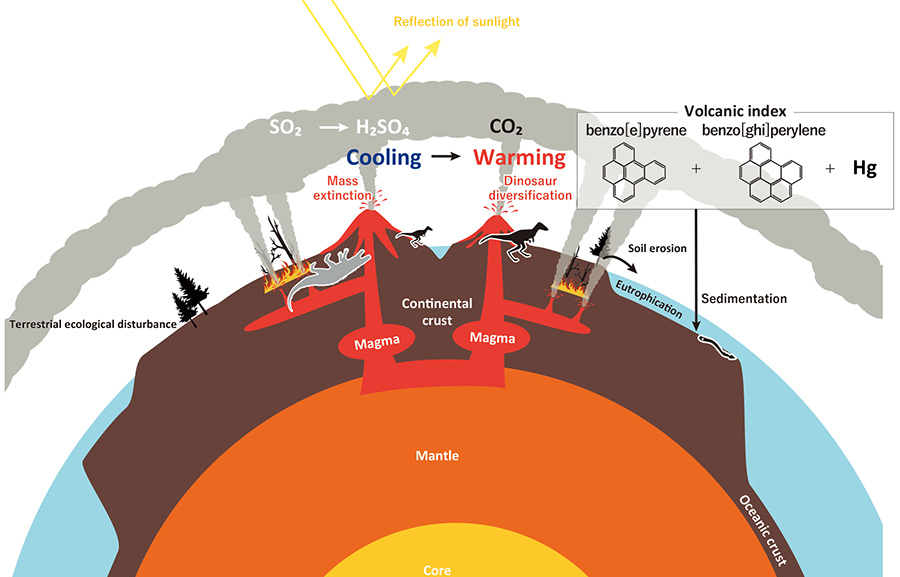
If today’s episode seems to have a lot of stuff related to Earth and its life, this is because Earth is a planet, and a large part of why many people study geology and space science is to try and keep humanity safe. We often remind you that space is trying to kill you, but we would be remiss if we didn’t admit that sometimes the Earth is trying to kill us, too.
Over the course of history, there have been five major extinction events that have come and gone. At the end of the Triassic Period, about 201 million years ago, 60-70% of marine and land animals, including the massive crocodilian line of reptiles, all died off and made space for dinosaurs to emerge, grow, and eventually become farmyard chickens.
Evolution is weird, y’all.
It’s been suspected that massive volcanic eruptions caused the end of the Triassic, and a new analysis of marine rocks seems to back this up. Researchers found the kinds of minerals enrichments – benzopyrene plus benzoperylene plus coronene and other molecules – tied to eruptions high in sulfur dioxide and low in carbon dioxide. These are the kinds of eruptions that drop global temperatures, create sulfuric acid aerosols, and are generally bad for your typical cold-blooded crocodilian-line reptile.
Personally, I think the dinosaurs were way cooler than the giant lizards, but apparently, the Universe didn’t agree because space flung a rock at us, and thus ended the dinosaurs. And that helped bring us chocolate. Pamela? Do you have a story on this?

Apparently, the phrase “one person’s trash is another person’s treasure” applies even in the context of geology. When the ten-kilometer across dinosaur-killing asteroid struck, it carved out a crater roughly 150 kilometers across, and that crater’s rim runs through what is the modern-day Yucatan peninsula. Scattered outside this ring is a series of sinkholes – cenotes – that are archeologically a gift that keeps on giving. These caverns in the desert collected water and were used throughout history for everything from burial sites to living sites, and it turns out that they were even used for growing the cacao plant that is the great giver of chocolate.
The Mayans used cacao beans as currency, and historic records talk about sacred groves where the plants were raised; you don’t want your currency to grow just anywhere after all. The location of these groves had been a huge mystery.
In general, the drier climate of the Yucatan is inhospitable to the cool, humidity-loving shade tree that is cacao. In what I consider an amazing leap of creativity, researchers were inspired to check out the sinkholes as possible growing sites, and they found evidence of the ancient groves.
In a new paper in the Journal of Archaeological Science Reports, researchers led by Richard Terry identify nine sinkholes that have the biomarkers – including caffeine – for cacao, along with archaeological evidence, and in one case, a remnant grove of trees.
So, basically, because of an asteroid that killed the dinosaurs, a series of sinkholes formed in the Yucatan that allowed the Maya to hide their currency-producing plants underground, fund a massive highway system, and become a super cool culture in Earth’s history.
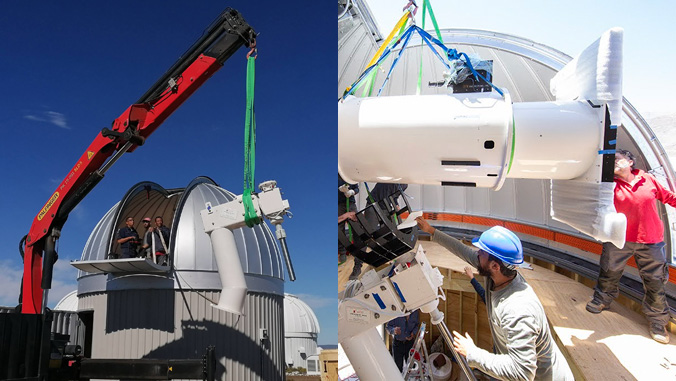
Before you start worrying about the next big asteroid to attack – and this is a real concern – I want you to know that there are several observing programs around the world dedicated to identifying all the space rocks of potentially dangerous size and orbit.
Currently, there are no known objects in dangerous orbits for at least a hundred years.
One of the workhorses of this field is the Asteroid Terrestrial-Impact Last Alert System, or ATLAS, which has given its name to a number of comets while logging asteroid after asteroid. And this workhorse system is getting expanded from its two Hawaiian locations to include new observatories in South Africa and Chile. This means that if a killer space rock comes at us from the extreme south, we will, when the new facilities become fully operational, be able to spot it. And between all four telescopes, we can monitor the entirety of our dark skies every 24 hours.
Now, we just need the asteroid protection system that sci-fi keeps promising.
Still, as much as we get frustrated by what actual science and engineering can’t do, it’s amazing to look back at just how far we have come. In our next story, Erik Madaus takes us back to 1967 and the Lunar Orbiter 3.
This Week in Rocket History
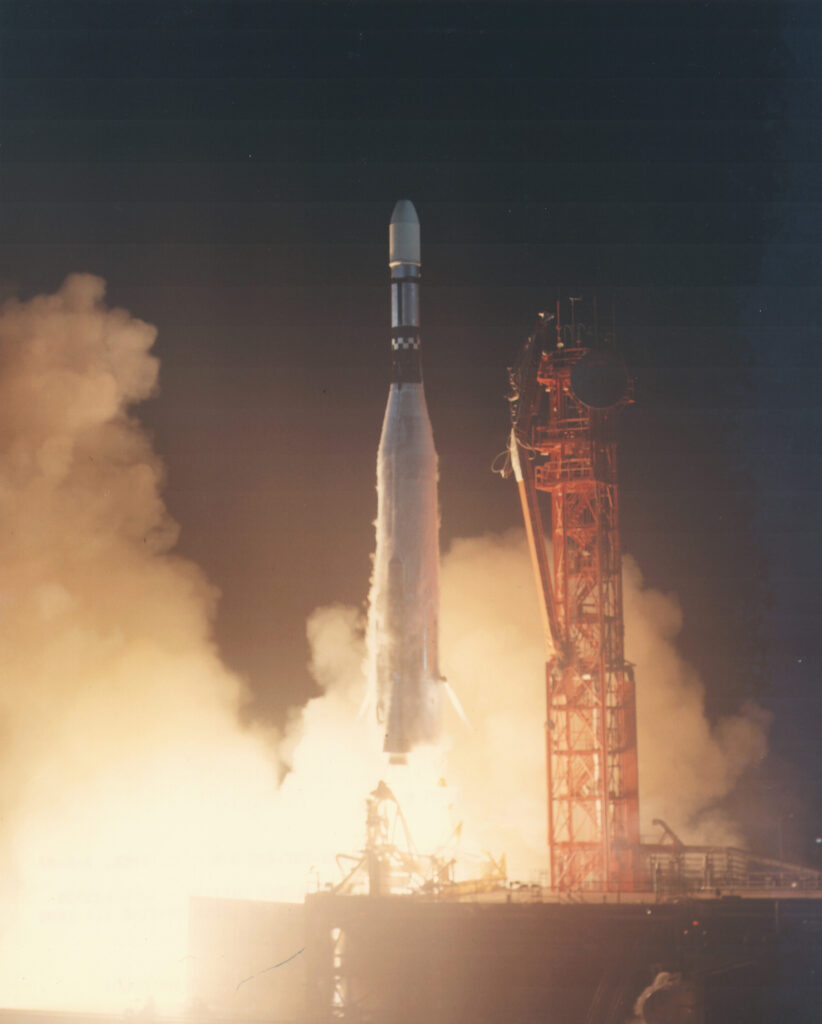
This week in rocket history is Lunar Orbiter 3, one of the missions that prepared for the Apollo moon landings.
Following on from the Ranger series of impactors, the Lunar Orbiter spacecraft were a series of spacecraft that NASA sent into lunar orbit to survey the surface for candidate landing sites for the future Apollo missions. They weighed 385 kilograms and consisted of a cone with four fixed solar panels, a propulsion system, and a camera system that used two lenses to expose images onto the same frame of 70-mm film – an 80-mm lens for medium resolution and a 610-mm lens for high resolution. The film was developed in the spacecraft using a process from a then classified reconnaissance satellite called Samos E-1 and transmitted digitally back to Earth for analysis.
Lunar Orbiter 3 launched on February 5, 1967, on an Atlas-Agena rocket on a three-day trip to the Moon. Its primary mission was to survey candidate landing sites identified by Orbiters 1 and 2 at a higher resolution to confirm their suitability.
The spacecraft’s mission lasted from February 8 to 23, 1967. Four days into the mission, the spacecraft lowered its perilune – the lowest point in its orbit around the Moon – from 200 kilometers to 55 kilometers to obtain higher resolution images. After all the images were captured, most were developed and transmitted back to Earth. However, the mechanism which advanced the film into the developer failed on March 4, leaving about a quarter of the images unable to be developed and scanned. Despite this failure, the spacecraft still returned almost 500 high-resolution images and 149 medium-resolution images. One of these showed the Surveyor 1 spacecraft at its landing site.
Besides its imagery mission, the spacecraft also carried radiation and micrometeoroid detection instruments, which returned data on the lunar environment.
The spacecraft was tracked from Earth for several months for lunar geodesy and communication tracking purposes before being commanded to deorbit and impact the Moon in October 1967. All Lunar Orbiters were commanded to deorbit before their maneuvering thrusters were depleted to avoid becoming navigation hazards to crewed Apollo spacecraft. Lunar Orbiters 1, 2, 3, and 5 were commanded to deorbit in 1967 and 1968, while Lunar Orbiter 4’s orbit naturally decayed after contact was lost.
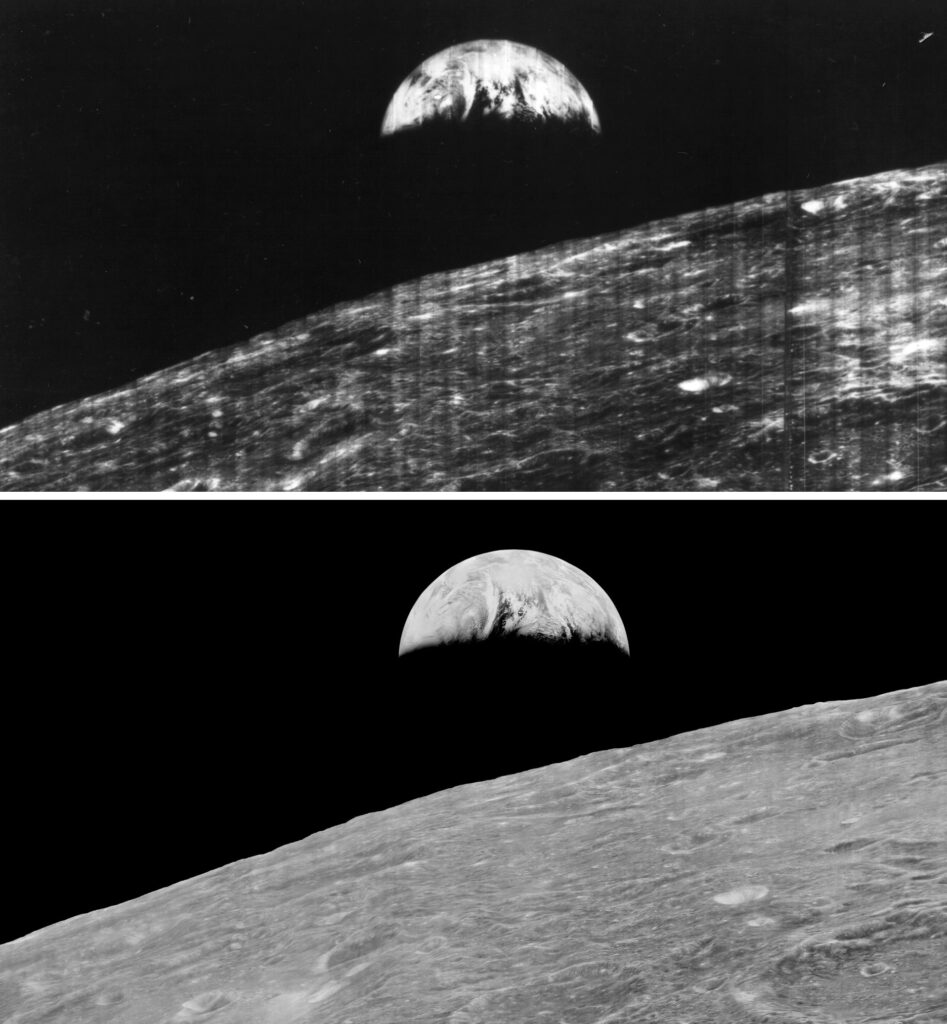
Decades later, a small team of dedicated nerds who met on an Internet forum rescued the 1,498 data tapes full of downlinked images from all five Lunar Orbiters. The goal in reprocessing the 40-year-old images was to compare them to new images taken by the Lunar Reconnaissance Orbiter, launched in 2009.
The tapes were supposed to have been destroyed in the 1980s but were fortunately saved and left in a barn. The team refurbished old tape drives the size of a refrigerator to be able to read the tapes. In all, they had four tape drives and were able to restore two to working condition.
In addition to the tape drives, they needed to recreate from scratch the hardware used to convert the raw signal data into images, a process called demodulation.
The original Lunar Orbiter images were just as good as the modern ones, but digital processing techniques in the 1960s were quite primitive compared to modern techniques. One of the more significant images, the first “Earthrise”, was taken in 1966, and the scan at that time was low quality. The Lunar Orbiter Image Recovery Project was able to reprocess the original data and produce a much higher quality image, which was released in 2008.
The program was heavily supported by NASA, totaling $700,000 plus hardware and facilities. They also got additional crowdfunding to finish the process. The work was carried out in a former McDonald’s at NASA Ames Research Center, named McMoon by the project.
Statistics
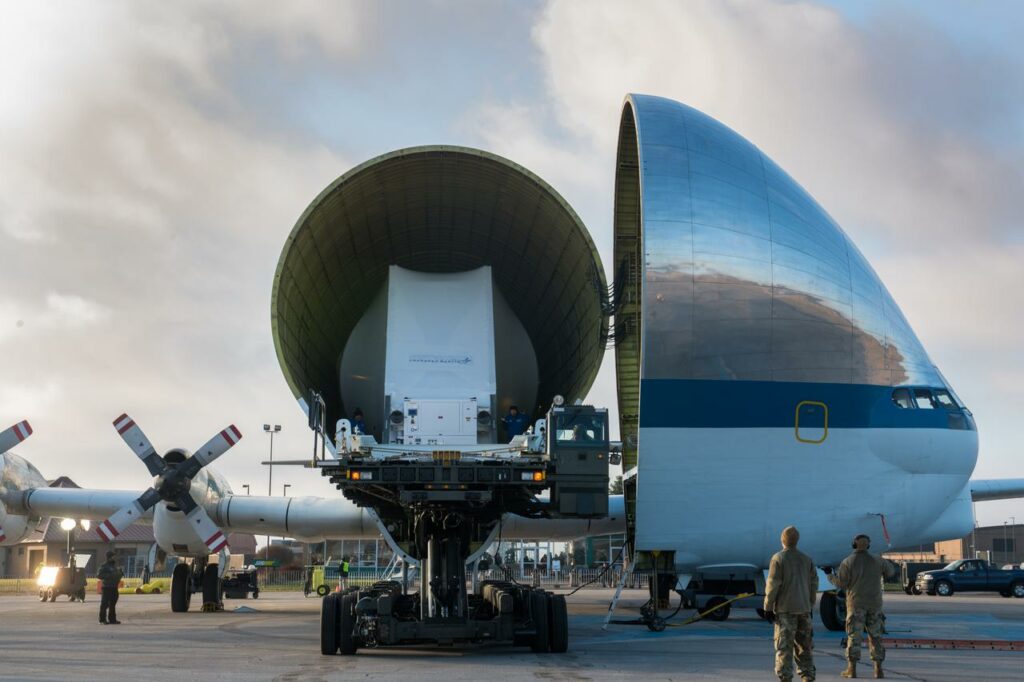
And now, for some statistics.
The number of toilets in space is still eight: four on the ISS, one on the Soyuz, one on the Crew Dragon, one on Shenzhou 13, and one on Tianhe.
We keep track of orbital launches by launch site, also called spaceport. Here’s that breakdown:
USA 6
China 2
From those eight launches, a total of 215 spacecraft were put into orbit.
Your random space fact for this week is more people flew in the space shuttle than NASA’s super guppy transport aircraft.
This has been the Daily Space.
You can find more information on all our stories, including images, at DailySpace.org. As always, we’re here thanks to the donations of people like you. If you like our content, please consider joining our Patreon at Patreon.com/CosmoQuestX.
Credits
Written by Pamela Gay, Beth Johnson, and Erik Madaus
Hosted by Pamela Gay, Beth Johnson, and Erik Madaus
Audio and Video Editing by Ally Pelphrey
Content Editing by Beth Johnson
Intro and Outro music by Kevin MacLeod, https://incompetech.com/music/


 We record most shows live, on Twitch. Follow us today to get alerts when we go live.
We record most shows live, on Twitch. Follow us today to get alerts when we go live.